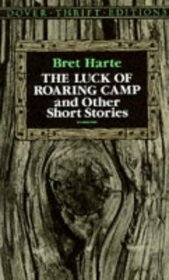The "Introduction" explains how Bret Harte submitted this first group of short stories to his California publisher, who was appalled and begged the author to reconsider publishing them. Countless erudite people were asked to read them and give honest opinions. The California consensus was there was no consensus; different folks had differing views on the value of the stories. Finally, Bret Harte told his publisher to publish, or he would go elsewhere. The publisher reluctantly agreed and waited for the backlash from the Eastern press. It never came.
Harte was hired to write more stories -- directly by Eastern publishers. Harte rode the wave of nostalgia taking hold of the country. The West was disappearing, and Easterners wanted to savor what made the West distinctive -- hard-working cowboys, brutal criminals, and harder lawmen. Dime Novels were (the common name for inexpensive novels with Western themes) and colorists (authors like Bret Harte, who wrote regional realism) captured people's imaginations.** These books flew off the store shelves and were read by dozens of readers before the booklets fell apart from heavy use. Reading a dime novel was a guilty pleasure.
What was regional realism? The easiest way to explain this is to give a synopsis of the first story of THE LUCK OF ROARING CAMP. Roaring Camp has been besieged with bad luck for years. Suddenly, things change with the birth of Cherokee Sal's son. She dies in childbirth; the camp names the boy Thomas Luck. After the camp members name Tommy, they raise the boy themselves because they see Tommy as their good luck charm. Before long, the miners decide that fighting and gambling will badly influence the child, and they change their ways. The miners start taking care of their shacks while their language and appearances improve.
The goal of regional realism was to tell the story of plain folks, the difficulties they faced, and how they rose above them. Bret Harte showcased gamblers, miners, cowboys, and other romantic characters. He specialized in the California Gold Rush. Harte was multitalented; he wrote book reviews, editorials, lectures, magazine articles, plays, and poetry. However, Harte concentrated on short stories. He became so popular that he was an international celebrity. However, Harte came to prominence through hard work. Hart's father died when Bret was young, and the widowed Mrs. Harte took the family to California. By age 11, Bret had published some poetry. He worked many jobs to help with the household income by being a miner, a school teacher (like his father), an express messenger, a printer, and finally, a journalist.
Each short story in this slender volume is a vignette of life in California miners' camps. To today's readers, these stories may seem idealized and romanticized. However, Harte wrote for his audience.
** Almost a century before, in Great Britain, publishers created "Penny Dreadfuls," which were cheap, serialized stories for the masses. SWEENEY TODD and FRANKENSTEIN were early examples of British weekly fiction booklets. In their heyday, they sold one million copies each week. Later, they emerged as dime novels in America.
Harte was hired to write more stories -- directly by Eastern publishers. Harte rode the wave of nostalgia taking hold of the country. The West was disappearing, and Easterners wanted to savor what made the West distinctive -- hard-working cowboys, brutal criminals, and harder lawmen. Dime Novels were (the common name for inexpensive novels with Western themes) and colorists (authors like Bret Harte, who wrote regional realism) captured people's imaginations.** These books flew off the store shelves and were read by dozens of readers before the booklets fell apart from heavy use. Reading a dime novel was a guilty pleasure.
What was regional realism? The easiest way to explain this is to give a synopsis of the first story of THE LUCK OF ROARING CAMP. Roaring Camp has been besieged with bad luck for years. Suddenly, things change with the birth of Cherokee Sal's son. She dies in childbirth; the camp names the boy Thomas Luck. After the camp members name Tommy, they raise the boy themselves because they see Tommy as their good luck charm. Before long, the miners decide that fighting and gambling will badly influence the child, and they change their ways. The miners start taking care of their shacks while their language and appearances improve.
The goal of regional realism was to tell the story of plain folks, the difficulties they faced, and how they rose above them. Bret Harte showcased gamblers, miners, cowboys, and other romantic characters. He specialized in the California Gold Rush. Harte was multitalented; he wrote book reviews, editorials, lectures, magazine articles, plays, and poetry. However, Harte concentrated on short stories. He became so popular that he was an international celebrity. However, Harte came to prominence through hard work. Hart's father died when Bret was young, and the widowed Mrs. Harte took the family to California. By age 11, Bret had published some poetry. He worked many jobs to help with the household income by being a miner, a school teacher (like his father), an express messenger, a printer, and finally, a journalist.
Each short story in this slender volume is a vignette of life in California miners' camps. To today's readers, these stories may seem idealized and romanticized. However, Harte wrote for his audience.
** Almost a century before, in Great Britain, publishers created "Penny Dreadfuls," which were cheap, serialized stories for the masses. SWEENEY TODD and FRANKENSTEIN were early examples of British weekly fiction booklets. In their heyday, they sold one million copies each week. Later, they emerged as dime novels in America.




